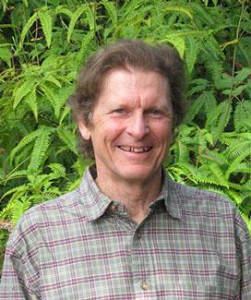
PAUL BANKO
-
Who are you and what do you do?
I am a Research Wildlife Biologist for U.S. Geological Survey, Pacific Island Ecosystems Research Center, located at Kīlauea Field Station in Hawaii Volcanoes National Park. My career has been focused in Hawai‘i, investigating the conservation biology of Hawaiian birds, with emphasis on causes of population decline, feeding ecology, and population and habitat restoration. Although my research typically involves endangered bird species, I also study arthropods, particularly ants, parasitoid wasps, and butterflies and moths, in collaboration with others. Entomological work has taken me to the National Park of American Samoa and Rose Atoll National Wildlife Refuge, and I have been fortunate to work with wildlife on several of the northwestern Hawaiian Islands that are part of Papahānaumokuākea National Marine Sanctuary. My formal education includes a BS degree (1972) in Zoology and Botany from the University of Washington and PhD (1988) in Wildlife Science, also from the University of Washington. My informal training includes many years of collaboration and inspiration from many colleagues inside and outside The Wildlife Society and from the legions of great volunteers who have worked on our projects.
-
What got you interested in wildlife and wildlife or habitat restoration? Any specific issues or species? What is your favorite plant and/or animal?
I became interested in wildlife during my early years growing up at Red Rocks Lake Wildlife Refuge in southwestern Montana. My father, Win Banko, spent most of his career working on endangered species problems with the U.S. Fish and Wildlife Service, and I accompanied him on many field trips after our family moved to Hawai‘i. The first scientific expedition through Kīpahulu Valley, on Maui, in 1967 was especially memorable for me, as several rare birds species were observed for the first time in many years and the forest and streams were magnificently wild and relatively lightly touched by invasive species.
-
What was a project you’ve worked on that you think had the best outcome/biggest success or that you’re proud of?
The Palila Restoration Project marks the highpoint of my career in restoration biology. The palila is an endangered species of Hawaiian forest bird that specializes on the seeds of a native tree, māmane, which is most abundant in subalpine habitat on Mauna Kea Volcano. Today, palila are found in just a tiny portion of their former range due mainly to a century of massive habitat destruction by introduced sheep and other ungulates. They are also threatened by a changing fire regime due to introduced grasses and other weeds; introduced predators, such as feral cats; and drought conditions, which seem to be increasing in severity and frequency in high-elevation habitats due to climate change. The project involved work on many facets of palila life history and included intensive ecological studies of the māmane tree. An important element of the project involved translocating palila from the western slope of Mauna Kea to the northern slope, where improving habitat conditions warranted a pilot study to assess the potential for palila reintroduction. This effort resulted in a small breeding colony that persisted on the northern slope for about five years. Although the colony of birds and the project as a whole could not be sustained due to funding constraints, I will forever be grateful to the hundreds of technicians and volunteers who labored mightily over the course of decades to demonstrate how declining populations and badly damaged habitats can be restored. Many of these people have gone on to productive careers in wildlife conservation, and even though who followed a different path will undoubtedly always cherish their time working with others to recover a critically endangered species and its habitat.
-
If you could choose only one restoration tool (e.g., fire, tractor, herbicide, pesticide, irrigation, seeder, brushhog, mulcher or any other tool of your choosing) which one would you choose and why?
The essential restoration tool in most Hawaiian ecosystems is removing ungulates. Methods for doing this vary, but most involve fence building and shooting. Nevertheless, ungulate removal is only the first step towards restoring heavily damaged habitats because there are often serious invasive weeds that require control immediately after browsing pressure is released. At the same time, introduced mammalian predators, including rats, cats, and mongooses, pose serious threats to many Hawaiian birds. Controlling small mammals at meaningful spatial scales will most likely require toxic baits, but smaller areas might be treated by trapping with self-resetting traps. We have begun a new project in an ungulate-free area to assess the response of native birds, arthropods, and plants to the removal of rats and invasive predatory wasps and ants. This work will also provide information about the efficacy of removing small invasive predators from special ecological areas using toxic baits.
DOMINIC BARRETT
-
Who are you and what do you do?
Since 2009, I have worked for the US Fish and Wildlife Service Arizona Fish and Wildlife Conservation Office as a Fish and Wildlife Biologist. I am responsible for coordinating efforts for the Partners for Fish and Wildlife Program on private and tribal lands for the Arizona Fish and Wildlife Conservation Office. I work to restore, enhance, and establish aquatic and terrestrial habitats for federally protected species, migratory birds, and species of special concern. In addition to my normal responsibilities, I serve as a co-chair for the Intermountain West Joint Venture Arizona State Conservation Partnership. The Partners for Fish and Wildlife Program and Intermountain West Joint Venture provide unique opportunities for private, state, and federal landowners interested in improving habitat for a diversity of species.
I received a M.S. from Oklahoma State University (Natural Resource Ecology and Management, Wildlife Ecology and Management Option) and a B.S. from Southeastern Oklahoma State University (Conservation, Fisheries and Wildlife Options). My previous work experiences include fisheries and wildlife management, terrestrial habitat management, and fish and wildlife research. Previous employers include state and federal agencies and universities.
-
What got you interested in wildlife and wildlife or habitat restoration? Any specific issues or species? What is your favorite plant and/or animal?
It’s my Dad’s fault! Fortunately, he introduced me to the outdoors and showed me a great appreciation for everything natural. For as long as I can remember, I have been fascinated by the outdoors and aquatic and terrestrial wildlife. I spent many days outside while hunting, fishing, hiking, camping, boating, and exploring rural Oklahoma. Without numerous opportunities and my father’s support and encouragement in outdoor recreation, I would have never pursued a career in fisheries and wildlife conservation.
As a generalist, I never decided between fish and wildlife disciplines (hence pursuit of a B.S. with Fisheries and Wildlife Options). After completing a M.S., I soon realized that many positions with state and federal agencies would not accommodate my innate, diverse interests (e.g., fish, wildlife, aquatic, terrestrial). I didn’t consider a career in habitat restoration until gaining exposure to riparian restoration activities along the lower Colorado River on Cibola National Wildlife Refuge. The feeling of accomplishment was tremendous, even with relatively small restoration projects. Restoration efforts on the Refuge provided opportunities for funding, additional work, partnerships, and immediate impacts on resident and migratory wildlife. I then realized that restoration efforts and employment with the Partners for Fish and Wildlife Program would allow me to pursue fish and wildlife interests through aquatic and terrestrial habitat restoration.
My favorite plant and animal is the Arizona sycamore and northern river otter. Arizona sycamore is found throughout riparian areas of Arizona, eastern New Mexico, and northern Mexico. It is a magnificent tree with sometimes twisted, gnarly branches, multiple trunks, and individual character. Once occurring throughout Arizona, river otters (within the state) are now limited to the Verde River watershed in central Arizona. River otters captivated me during research efforts associated with my M.S. in Oklahoma. Their combination of playfulness, sociality, hunting abilities, and teamwork are intriguing. River otters are amazingly efficient at capturing aquatic prey.
-
What was a project you’ve worked on that you think had the best outcome/biggest success or that you’re proud of?
I’m most proud of a small wetland project completed with the Town of Pinetop-Lakeside in eastern Arizona. The project involved multiple partners who came together to establish wetland habitat for waterfowl, wading birds, amphibians, and native fishes. The project provides important opportunities for natural resource education via a hiking trail, viewing platform, and educational signage. The viewing platform allows local science classes to gather and discuss wetlands and wildlife habitats. Educational signage provides visitors information about wetland conservation, restoration, wildlife, and other topics. During wetland construction, we also provided a training opportunity for tribal natural resource agencies. Seven tribes from Arizona and New Mexico were represented during the workshop. In the end, the established wetland is small but impacts of all project components are immeasurable.
-
If you could choose only one restoration tool (e.g., fire, tractor, herbicide, pesticide, irrigation, seeder, brushhog, mulcher or any other tool of your choosing) which one would you choose and why?
Although not a tool per se, I would choose partnerships. Partnerships are fundamental. Partnerships are the foundation of restoration. Partnerships afford restoration specialists many things; most importantly, partnerships create opportunities, improve our actions, increase cost effectiveness (leveraging funds), increase impacts, and often increases efficiencies. Rarely can restoration projects succeed without strategic partnerships. Partnerships bring together funding sources, landowners, researchers, managers, and others that support restoration efforts. Without partnerships, what would be accomplished? For me, nothing could be accomplished without partnerships with private landowners and other agencies.
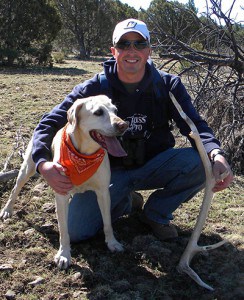
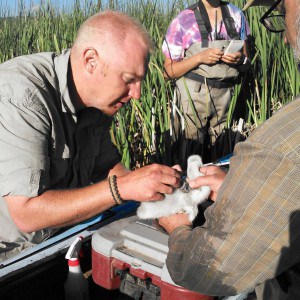
David Bush
-
Who are you and what do you do?
I am a masters student at Idaho State University. I am researching the cause of high Trumpeter Swan cygnet mortality on Gray’s Lake National Wildlife Refuge. I received my B.S. in biology at Idaho State University as well. An aspect of research I am interested in is using cameras to monitor wildlife less intrusively. In my current research I am mounting video cameras on swan nests to monitor incubation behavior.
-
What got you interested in wildlife and wildlife or habitat restoration? Any specific issues or species? What is your favorite plant and/or animal?
If I had to place blame as to why I am interested in wildlife I would have to put it on my parents. We went camping often, and during those trips I was encouraged to explore and interact with my surroundings. When we weren’t camping I was always watching Mutual of Omaha’s Wild Kingdom and Discovery Channel documentaries on wildlife. My parents were constantly barraged with random animal facts. They always pushed me to learn and experience more.
-
What was a project you’ve worked on that you think had the best outcome/biggest success or that you’re proud of?
The project I am most proud of was one in which Dr. Charles Peterson and I looked at post-wildfire affects on rattlesnake hibernaculum. In 2011 a wildfire burned through a large portion of the Southeast Idaho desert. Once all the vegetation was burned, it allowed for the wind to blow much of the sandy soil around and into the entrances of hibernaculum. We were worried that the sand would eventually completely block the entrances forcing the rattlesnakes to move elsewhere. In order to monitor the snakes we mounted a trail camera at the entrance to the den. However, when we first checked the camera we only had images of snakes when other wildlife was in the picture. After doing a little research we found out that these cameras use a mixture of motion sensing and infrared technology in taking pictures. Since rattlesnakes are the same temperature as their environment, they were not causing the camera to take pictures. We remedied the situation by changing the cameras settings to where it would take one picture every minute. This caused me to have to look through just over 52,000 images. I had to leave the project after 2 seasons, but due to its cost-effective nature Dr. Peterson is now using it to give undergraduates the experience of doing real ecological work.
-
If you could choose only one restoration tool (e.g., fire, tractor, herbicide, pesticide, irrigation, seeder, brushhog, mulcher or any other tool of your choosing) which one would you choose and why?
This is a very difficult question. I feel like each tool used in restoration is very specific to the job at hand. If I had to have just one tool I would say some good boots. You can have every tool available to you, but until you get into the field and see firsthand what is happening those tools are meaningless. Before I started my current project I read as much as I could about swans and wetlands, and I felt like I learned that I didn’t want to work on wetlands. I felt like I would always be cold, wet, and covered in mosquitos and leeches. However, once I got my boots on and started working I realized how much I love it. Sure, I am still covered in mosquitos, I am often wet, and sometimes I am rather cold. But if I had just gone off what I read I would have never got out in the marsh and started trying to figure out what was going on.
Rick Miller
-
Who are you and what do you do?
I am retired from the Arizona Game and Fish Department after over 30 years. I graduated from New Mexico State University with a Bachelors in Wildlife in 1973 and then went to Thailand in the Peace Corps work with the Royal Thai Forestry Department, Division of Wildlife. While I was in Thailand I learned that I really did not know how to manage wildlife. So when I got back to the USA, I decided to go to graduate school in order to learn how to do the work. I ended up with a PhD from the University of Wyoming. At that point I found work with the Arizona Game and Fish Department. While with AZGFD I worked on inventories and habitat use assessments, as a planner, and for twenty years as a Habitat Specialist and Habitat Program Manager in Flagstaff.
-
What got you interested in wildlife and wildlife or habitat restoration? Any specific issues or species? What is your favorite plant and/or animal?
It is a cliché but, when I was growing up my Dad took us hunting, fishing and boating, and I learned to really like it, especially quail hunting. When I found out I hated my first major in college (business), I asked the counselor if there was such a thing as a degree in wildlife. Rather than an interest in a specific animal, I am most interested how the plants and animals work together to hopefully form a resilient system. I find the details of the system endlessly fascinating. Restoration is very interesting to me because it requires an understanding of the underlying system, and most often shows how much we don’t understand. I do however have a favorite species of plants: penstemons.
-
What was a project you’ve worked on that you think had the best outcome/biggest success or that you’re proud of?
The Anderson Mesa Restoration Project was probably the largest success I have been involved in. Working with ranchers, Forest Service, AZGFD, NRCS, the Arizona State Land Department and various NGOs (critter groups) we worked to restore grasslands and openings in pinyon juniper and ponderosa pine forests. This project was special because we were trying to solve a specific problem (poor recruitment of pronghorn fawns), we got to work on a landscape scale, we were working with good people, and it seemed to benefit the pronghorn. In roughly ten years we were able to treat about 160,000 acres.
-
If you could choose only one restoration tool (e.g., fire, tractor, herbicide, pesticide, irrigation, seeder, brushhog, mulcher or any other tool of your choosing) which one would you choose and why?
If I could only chose one tool it would probably be a tree grinder or brush hog because we had so much success using it on Anderson Mesa. We tried a number of methods for removing young juniper and pines from grasslands and openings, but the brush hog was the best, because it worked on a variety of different sized trees, covered a large area quickly and if used correctly did not require follow up. My second choice would be a chain saw in the hands of a good sawyer, because it can cut in areas where you can’t use the brush hog, such as rocky ground, which we have a lot of.
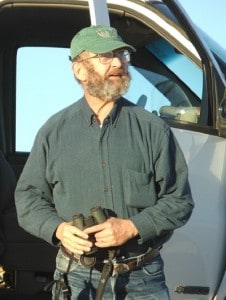
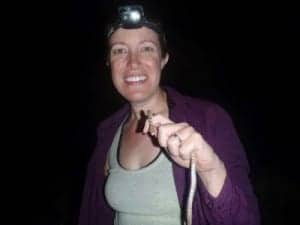
Tiffany Sprague, Arizona State Master’s student examining the microhabitat use of the northern Mexican gartersnake.
TIFFANY SPRAGUE
-
Who are you and what do you to?
After graduating from University of Arizona with a B.S. in Wildlife Sciences in 2001, I began a career as a wildlife biologist, working with the National Park Service, Arizona Game and Fish Department, Arizona Army National Guard, and Northern Arizona University. My primary field projects focused on the Sonoran desert tortoise, black-footed ferret, various bat species, and habitat restoration. I also spent a bit of time at the Arizona Science Center, planning educational events and giving planetarium presentations.
Through all of this, I remained an active member and volunteer with a number of conservation organizations. In 2006, I was able to realize my dream of actually working for one of these organizations when I accepted a position with Sierra Club’s Grand Canyon (Arizona) Chapter. As Chapter Coordinator and Publications Editor, I focus on education and outreach regarding public lands, wildlife, and energy issues and also help develop and implement projects such as wildlife and habitat restoration, water resource monitoring, and more.
Last year, I began pursuing a new chapter in my life: my Master’s degree. Working with individuals at Northern Arizona University, Arizona State University, Arizona Game and Fish Department, and other entities, I developed a project proposal to assess microhabitat use of northern Mexican gartersnakes at Bubbling Ponds Fish Hatchery. I am now enrolled in the Applied Biological Sciences program at ASU. I am continuing part-time employment with Sierra Club and am also working part-time for ASU, which provides an interesting blend of responsibilities and learning opportunities.
-
What got you interested in wildlife and habitat restoration?
My goal in life has always been this: to save the world. Since my youth, I have had an affinity for the wild places in the world and have always been drawn to the diversity of species that call these areas home. I believe that humans must minimize impacts to these wild lands and wildlife; our place in this world is not to conquer nature but to, instead, be a part of it. I have dedicated my life to protecting nature and to educating and inspiring others to do the same.
-
What are some of the challenges that you’ve faced while working on a project?
One of the primary challenges that I continually face is other people’s perspectives. These perspectives are diverse, ranging from hatred to apathy to ignorance to selfishness to misguided zeal. Examples include the following: people who believe that nature is something to be triumphed over and who view anyone seeking to protect it as an enemy; people who just don’t know or care enough to realize that their actions affect the resources upon which we all depend; those who may see problems with the way we treat natural resources but are unwilling to assist or who are more interested in blaming everyone else rather than taking responsibility for their own actions; and people who are either so engaged in a single issue that they don’t realize the consequences in other areas or who are so eager to be involved that they don’t engage in an effective and sustainable way. I believe that education is the best tool available to overcome each of these perspectives and attitudes. By sharing knowledge and experiences with the public, elected officials, my peers, and, of course, myself, I can help find common ground among different entities and inspire effective action toward protecting our world.
-
Does your work involve community outreach, and if so, what is your strategy for getting the community on board with your restoration efforts?
My work with Sierra Club has impressed upon me the importance of community outreach. As a grassroots organization, our primary goal is to engage others in “exploring, enjoying, and protecting the planet.” Our strategy for getting the community on board is to share knowledge as well as opportunities to get involved. However, due to varying perspectives, we are often seen as a controversial organization and, therefore, receive push-back from others. I receive similar push-back in my endeavors to protect our wild places and resources, which is why I am committed to continue educating myself and to sharing knowledge with others.
-
Tell us about a project you are currently working on.
As noted above, I will be assessing microhabitat use of northern Mexican gartersnakes at Bubbling Ponds Hatchery. In mid-2014, this species was listed as threatened under the Endangered Species Act; habitat loss and degradation is the chief threat facing this species. Bubbling Ponds appears to support a robust population, although it is generally unknown why. Habitat restoration and modification efforts are planned in others areas of the species’ range, and a goal of the agencies responsible for these lands is to make them more suitable for this sensitive species. The goal of my research is to determine what features at the hatchery are preferred by the snakes in order to help guide future restoration and modification activities.
My field work will begin in April 2015. Stay tuned for volunteer opportunities! Just to help sweeten the deal, this is an aquatic snake that inhabits stunningly beautiful areas. Plus, Bubbling Ponds happens to be right next to a winery….
KRYSTEN ZUMMO
-
Who are you and what do you do?
My name is Krysten Zummo, I am currently a Master’s student at New Mexico State University in Las Cruces, NM. I have been actively involved with TWS since 2008 and currently serve as Chair-Elect of the Student Development Working Group as well as a board member for the New Mexico chapter. I obtained by Bachelor’s degree from SUNY Cobleskill in upstate NY and have primarily focused my research and interest on the relationship between avian ecology and landscape management practices.
-
What got you interested in wildlife and habitat restoration?
I have always been active in the outdoors, so finding a career that allowed me to continue being active seemed like a good path. During my first semester in college I found that I had a passion for avian ecology; a field I continued to explore and gain an understanding for. A few years down the road, I now find myself drawn to positions that studied the relationship between avian ecology, land management practices, and ecosystem health.
-
What are some of the challenges facing Scaled Quail restoration efforts in the SW?
Scaled Quail have been facing population declines since the 1960’s. Encroaching shrubland due to overgrazing of cattle and long term drought are considered the primary causes for their decline. Although Scaled Quail populations are declining at similar rates to Northern Bobwhites, bobwhites have been and continue to be the more charismatic species for research. As such, there is a lack of the needed information on Scaled Quail ecology and seasonal habitat requirements that would help managers understand how to restore lands in a valuable way to Scaled Quail populations.
-
Can you tell us about what habitat restoration efforts are under way in NM for Scaled Quail?
My Master’s thesis is focused on the effects that the BLM’s Restore New Mexico program is having on a local population of Scaled Quail in south central New Mexico, and whether or not the treated areas are beneficial to, and actively used by, Scaled Quail. The Restore NM program was initiated in 2005 and is a rangeland partnership program that is making efforts to restore healthy native grasslands, woodlands, and riparian areas to NM. The study area that I am working on was treated by the BLM in 2010 with tebuthiuron in an effort to control the encroaching creosote shrublands.
Should native perennial grass populations bounce back, all of the native grassland species will benefit. Seeing as creosote does not provide sufficient nutrients or cover for local animal populations, it isn’t a highly used. The return of the native grasses will mean more food and cover for terrestrial and aerial species a like, as well as for cattle.
-
Does your work involve community outreach, and if so, what is your strategy for getting the community on board with your restoration efforts?
My research involves local hunting organizations, as they have a vested interest in the health of the quail populations. These groups support the effort to restore the area and are hoping to see the populations rebound as a result.
I also keep in contact with the local ranchers who are currently leasing the land from the BLM. The ranchers are invested in the land and are very supportive of the BLM’s restoration efforts seeing as a return of the native grasses would also mean a higher availability of nutrients for their cattle. For the first 3 years after the treatment they were required to remove their cattle from the treated land in order to allow for the regrowth of native species. Even now that the 3 years has lapsed and the BLM no longer requires that they remove their cattle during this season, they continue to remove most of head of cattle on their own accord. So all in all, most of the community is in support of the restoration.
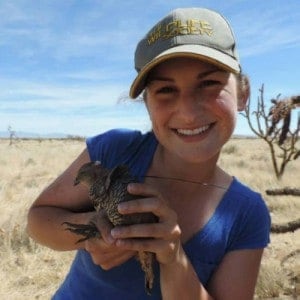
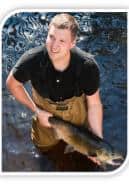
Jason Robison
-
Who are you and what do you to?
My name is Jason Robison. I am currently the Natural Resource Director at the Cow Creek Band of Umpqua Tribe of Indians in Roseburg, Oregon. I’m also a partner in Northwest Resource Solutions LLC., which is a small natural resource consulting firm which specializes in endangered species management and consultations. Prior to joining Cow Creek team, I worked as the Biological and Environmental Services Coordinator and the Land resources and Environmental Services Director for the Coquille Indian Tribe in North Bend, Oregon.
I obtained my Bachelors and Master’s degrees in Fish and Wildlife Management from Oregon State University. My graduate research focused on the Transmission of the Chewing Louse, Damalinia (Cervicola) sp., from Columbian Black-tailed Deer (Odocoileus hemionus columbianus) to Rocky Mountain Mule Deer (Odocoileus hemionus hemionus) and its role in Deer Hair-loss Syndrome.
I have been involved in The Wildlife Society since 2003 as a student mentor, presenter, and participating member.
-
What got you interested in wildlife and habitat restoration?
I have always been interested in the outdoors. I grew up hunting, fishing, camping, and hiking, like many people in the natural resource profession. I also grew up in a resource-based community. When the U.S. Fish and Wildlife Service listed the Northern Spotted Owl as threatened under the Endangered Species Act in 1990, I watched as the timber-based community in which I lived collapsed. It was at that point where I realized that in order to maintain a resource-based economy on a sustainable basis, social and ecological factors must be addressed. I enrolled in a Fish and Wildlife class as a high school freshman, and although I had a brief stint as a Mechanical Engineering major my freshman year in College, I reentered the Fish and Wildlife management field as a sophomore at OSU and never looked back.
-
What are some of the challenges facing habitat restoration efforts in Oregon?
I think the biggest challenge facing habitat restoration efforts in Oregon is a lack of knowledge and education as to how vital our natural resources are to our economy, while recognizing the importance of managing for the full suite of social and ecological values. The tremendous separation between industry and conservation has led to constant litigation and management gridlock, which has resulted in unhealthy, non-resilient watersheds. I believe there is a tremendous need to swing the pendulum back to the center by bringing conservation groups, private citizens, agencies, tribes, and industry together in a more unified, strategic, and sustainable whole watershed management approach that meets the economic, social, and ecological priorities of the local communities.
-
Can you tell us about what habitat restoration efforts are under way in the Umpqua Basin?
I am very excited to be working with my staff on three amazing projects within the Umpqua Basin.
First, as part of the Oregon Watershed Enhancement Board’s Focused Investment Partnership Program, my staff and I have been working to develop a conservation strategy that unites local watershed groups, state and federal agencies, and the timber industry on a strategic action and implementation plan for the entire Umpqua Basin. If successful, this strategic action plan will provide a detailed strategy for aquatic and upland restoration and management efforts throughout the entire Umpqua Basin.
In a similar manner, my staff and I have been working with the South Umpqua Rural Community Partnership, the U.S. Forest Service, and the Partnership for Umpqua Rivers on a large fish habitat restoration project in the Elk Creek watershed, another Tributary to the South Umpqua River. This project involves instream placement of logs, riparian habitat restoration, and a bridge replacement.
We have also just received funding to conduct a whole watershed restoration strategic action plan for the West Fork of Cow Creek. West Fork Cow Creek is a 55,914 acre, 5th-field watershed located in the South Umpqua sub-basin. This watershed has received little attention to address known limiting factors to fish, including the lack of quality fish habitat, fish passage barriers, and riparian condition. West Fork Cow Creek has populations of Chinook and Coho salmon, winter steelhead, and lamprey. Similar to the OWEB FIP process, this conservation project unites local watershed groups, state and federal agencies, and the timber industry on a strategic action and implementation plan for an entire sub watershed.
Additionally, my staff and I have been working with Oregon State University and the Oregon Department of Fish and Wildlife on a potential plan to site a one-of-a-kind research hatchery facility on Tribal lands within the South Umpqua Basin. When implemented, it is my hope that this facility will serve as an information hub for sustaining native fish populations into the future.
-
Does your work involve community outreach; and if so, what is your strategy for getting the community on board with your restoration efforts?
Absolutely! I think Tribes are uniquely situated to bring people together because of their long-term mindset, their outcome driven approach, and their historic ties to their ancestral areas. Personally, I like to participate in local community meetings and functions, while also staying involved in local, state, and federal agency policy advisory councils. To get public involvement, I think you have to show the public that you are personally invested in the process, and you are involved in the issues at all levels. I also think it is important to invite the public to the table early and often while planning restoration efforts.


